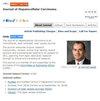基于中性粒细胞与嗜酸性粒细胞比率的机器学习模型可预测肝细胞癌术后复发
IF 4.2
3区 医学
Q2 ONCOLOGY
引用次数: 0
摘要
背景:循环中的嗜酸性粒细胞与肿瘤的发展有关。嗜酸性粒细胞相关指数--中性粒细胞与嗜酸性粒细胞比值(NER)可用于预测肿瘤患者的预后。然而,目前仍缺乏有效的 HCC 预后生物标志物。在这项研究中,我们旨在调查嗜酸性粒细胞比值的预测价值,并为 HCC 患者的复发建立一个最佳的机器学习模型。患者和方法:我们回顾性地收集了562名接受肝切除术并经病理诊断为HCC的患者。我们研究了NER与无进展生存期(PFS)之间的关系。我们开发了一个新的机器学习框架,其中包含 10 种机器学习算法及其 101 种组合,以选择预测肝切除术后复发的最佳模型。通过特征曲线和校准曲线的曲线下面积(AUC)评估了模型的性能,并通过决策曲线分析(DCA)评估了临床实用性:Kaplan-Meier曲线显示,低NER组的PFS明显优于高NER组。多变量考克斯回归分析显示,NER是术后复发的独立风险因素。随机生存森林(RSF)模型被选为最佳模型,具有良好的预测效果,优于TNM、BCLC和CNLC分期系统:结论:NER 对肝细胞癌患者术后复发具有良好的预测价值。基于 NER 的机器学习模型可用于准确预测。本文章由计算机程序翻译,如有差异,请以英文原文为准。
Machine Learning Model Based on the Neutrophil-to-Eosinophil Ratio Predicts the Recurrence of Hepatocellular Carcinoma After Surgery
Background: Circulating eosinophils are associated with tumor development. An eosinophil-related index, the neutrophil to eosinophil ratio (NER), can be used to predict the prognosis of patients with tumors. However, there is still a lack of efficient prognostic biomarkers for HCC. In this study, we aimed to investigate the predictive value of the NER and develop an optimal machine learning model for the recurrence of HCC patients. Patients and methods: A retrospective collection of 562 patients who underwent hepatectomy with a pathologic diagnosis of HCC was performed. The relationship between NER and progression-free survival (PFS) was investigated. We developed a new machine learning framework with 10 machine learning algorithms and their 101 combinations to select the best model for predicting recurrence after hepatectomy. The performance of the model was assessed by the area under the curve (AUC) of characteristics and calibration curves, and clinical utility was evaluated by decision curve analysis (DCA).
Results: Kaplan‒Meier curves showed that the PFS in the low NER group was significantly better than that in the high NER group. Multivariate Cox regression analysis showed that NER was an independent risk factor for recurrence after surgery. The random survival forests (RSF) model was selected as the best model that had good predictive efficacy and outperformed the TNM, BCLC, and CNLC staging systems.
Conclusion: The NER has good predictive value for postoperative recurrence in patients with hepatocellular carcinoma. Machine learning model based on NER can be used for accurate predictions.
Results: Kaplan‒Meier curves showed that the PFS in the low NER group was significantly better than that in the high NER group. Multivariate Cox regression analysis showed that NER was an independent risk factor for recurrence after surgery. The random survival forests (RSF) model was selected as the best model that had good predictive efficacy and outperformed the TNM, BCLC, and CNLC staging systems.
Conclusion: The NER has good predictive value for postoperative recurrence in patients with hepatocellular carcinoma. Machine learning model based on NER can be used for accurate predictions.
求助全文
通过发布文献求助,成功后即可免费获取论文全文。
去求助

 求助内容:
求助内容: 应助结果提醒方式:
应助结果提醒方式:


